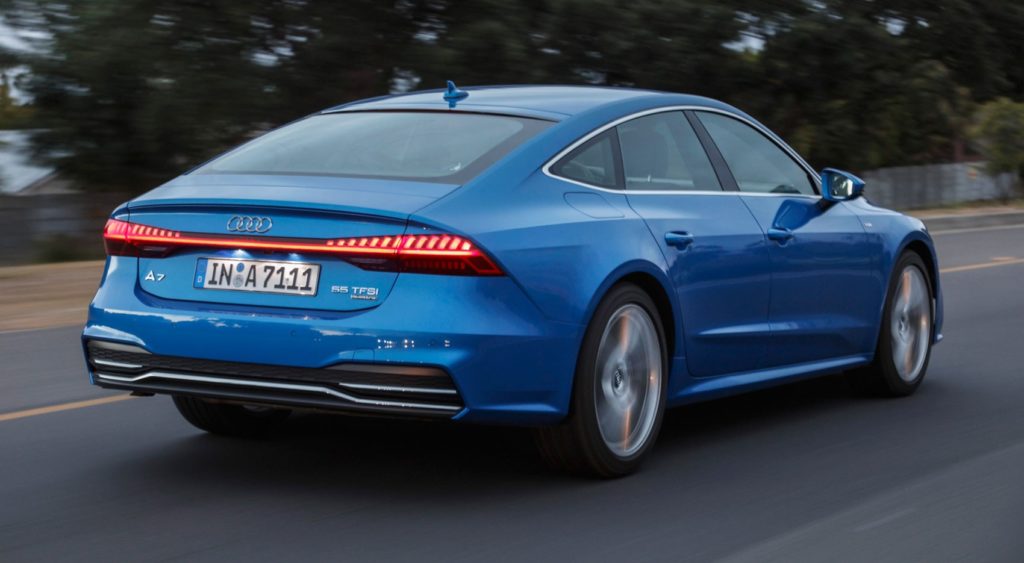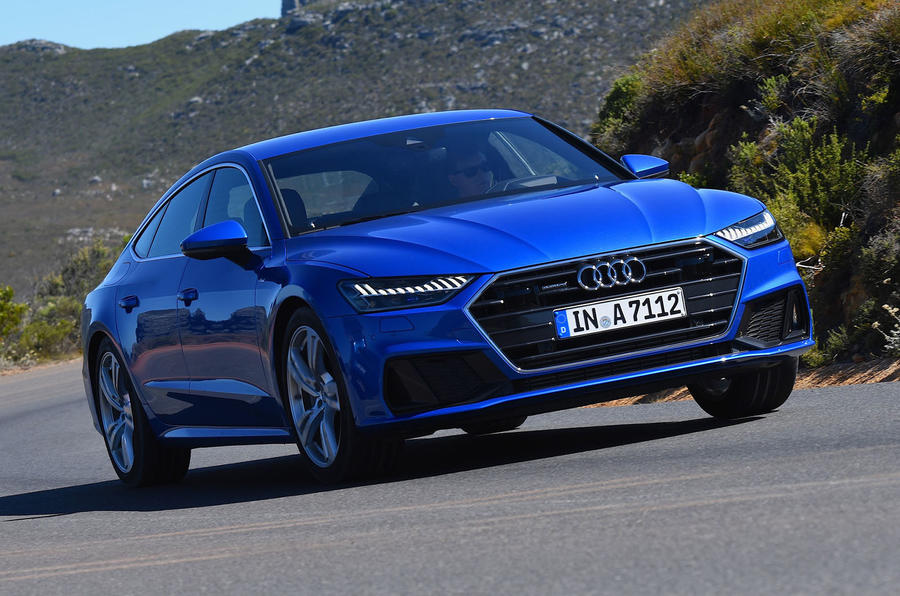2018 Audi A7 Sportback 55 TFSI Acceleration

Predictably given the enduring popularity of its predecessor, the main emphasis for the new A7 Sportback continues to be its design. Its exterior styling follows the same theme and swept back profile first established on its predecessor launched back in 2010, but with tauter surfacing and more precisely drawn feature lines that help to give it a more modern air. The five-door layout also remains as part of efforts to make it one of the most practical cars in its class; the cabin doors are once again frameless, while a large tailgate hinges from above the rear window to provide unimpeded access to the luggage compartment.
Despite the familiar appearance, however, the new Audi adopts a new platform as part of efforts to provide it with added space and improved refinement. The so-called MLB structure, which is shared with the upcoming new A6, is a development of that used by the old model, but with greater use of high strength steel and aluminium that while not contributing to any great weight loss or alteration in weight distribution does help to bring about considerable improvements in rigidity and stiffness.

There are also new drivelines, including a turbocharged 3.0-litre V6 petrol unit that finds home in the A7 Sportback 55 TFSI quattro driven here. In a development set to become a familiar feature right across the Audi line-up, it receives mild-hybrid properties thanks to the adoption of a belt driven alternator and lithium-ion battery. At speeds between 55km/h and 160km/h, the new Audi model can coast with its combustion engine idled for added fuel savings on extended periods of trailing throttle. It also uses a stop/start function that shuts down the engine below 22km/h as you roll up to traffic lights. In combination with a front camera, the engine is then restarted as soon as the car ahead begins to move or, alternatively, when the driver activates the throttle.
In other changes, Audi says the suspension has been developed from scratch and claims it offers greater levels of feedback. Buyers can choose between four set-ups: conventional steel springs, a sport suspension that lowers the ride height by 10mm, electronically controlled damping and a self-levelling air suspension that provides constant ride height.
That’s not all, though. In a move mirroring that of the larger A8, the new A7 Sportback also receives a number of contemporary new autonomous driving functions – some so new that they are not yet permitted to be operated in various countries where it is sold, including a so-called Traffic Jam Pilot function. Featuring Level 3 autonomy, it allows completely hands-free driving on roads with a central barrier, clear lane markings and no traffic light at speeds under 60km/h. In its most advanced form, the new Audi features up to five radar sensors, five cameras, 12 ultrasonic sensors and a laser scanner – the latter of which is integrated into its busy looking front end. They are networked by a so-called zFas central driver assistance controller. In total, the new car features 39 driver assistant systems, both as standard and optional.
At the rear, Audi has provided its latest model with an active spoiler element. Integrated into the trailing edge of the tailgate, it deploys at speeds above 120km/h to increase downforce on the rear axle for added high-speed stability. The most dominant styling feature, however, is the full-width tail-light treatment: each tail lamp receives 13 individual OLED elements, joined by an illuminated LED light bar that stretches across the rear of the boot lid. When you unlock the new A7 Sportback via the remote on the key fob, the tail lamps light up with a strobe effect that enhances its standing as one of the most advanced and, arguably, stylish road cars on sale today.

It is inside where Audi suggests the new A7 Sportback has made the biggest stride in terms of design – and on first acquaintance, its contemporary new dashboard, which is also shared with the upcoming A6 and also features technology launched on the larger A8, is certainly among the new car’s key selling points. The adoption of high definition digital instruments and touch-sensitive displays– an upper unit for the infotainment system and a lower unit for the air conditioning and other ancillary functions, including text input – provides it with a clean and uncluttered look devoid of traditional manual controls and switches.
To seasoned digital natives the new interior will come as a breath of fresh air. Others will likely take a good while before feeling entirely comfortable operating the two main displays, which require a firmer nudge and feature a greater acoustic feedback with a defined clicking sound than typical smart phone displays. The response time of the two displays is excellent even if they do struggle to properly convey all of their information as clearly as you may like in strong midday sunlight. Those seeking to reduce operating complexity would be well advised to consider the optional speech recognition system. It allows you to choose functions using typical conversational style commands and, in a move similar to that of the latest smart phones, pose questions on locations via the optional high definition navigation system.

Quality wise, the A7 Sportback is a bit of a mixed bag. The integration of the displays within the dashboard is excellent. However, the choice of black plastic for the air vents tends to cheapen the appearance of the otherwise excellent interior. Despite this, there is a pleasing solidity and ambience to the cabin, which has grown by 21mm in overall length despite the 14mm reduction in the length of the exterior.
Suffice to say, you can load the new Audi up with a vast array of optional equipment. Apart from the more advanced autonomous driving functions, the A7 Sportback offers Matrix LED headlamps with laser projector units, a new generation modular infotainment system with data transmission via LTE Advanced protocol and supporting a Wi-Fi hotspot in its most advance form, traffic sign information, a head-up display unit and four sound different systems including a Bang & Olufsen unit with 3D surround-sound. In a move following that of BMW and Mercedes-Benz, it can also be ordered with remote parking pilot and remote garage pilot – the latter of which autonomously manoeuvres the new Audi into and out of parking spaces or a garage without the need for a driver to be behind the steering wheel.

To drive, the initial petrol engine version of the new A7 Sportback is genuinely impressive, with plenty of performance and terrific mechanical refinement. Its new turbocharged 3.0-litre V6 engine, a unit developed in partnership with Porsche and also found in the latest Panamera, is delightfully smooth and subdued in nature on part throttle loads. Imbued with 250kW and a solid 500Nm of torque – some 5kW and 60Nm more than the older supercharged 3.0 V6 engine it replaces, it also pulls strongly when stirred and offers a plenty of flexibility into the upper reaches of the rev range.
2018 Audi A7 Sportback 55 TFSI quattro price and specifications
On sale: Mid-year
Price: $125,864
Engine: 3.0-litre V6 turbo petrol
Power: 340 PS or 335 bhp or 250 kW @ 5000 rpm
Torque: 500 Nm or 368 lb.ft @ 1370 rpm
Transmission: Eight-speed automatic, all-wheel drive
Fuel use: 6.8L/100km
Displacement : 2995 cm3 or 182.8 cu-in
VIDEO
Video by :Cars on Autobahn
Car information by : drive.com ,ultimatespecs.com
